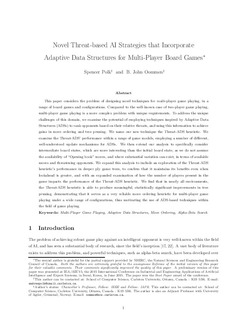| dc.description.abstract | This paper considers the problem of designing novel techniques for multi-player game playing, in a range of board games and configurations. Compared to the well-known case of two-player game playing, multi-player game playing is a more complex problem with unique requirements. To address the unique challenges of this domain, we examine the potential of employing techniques inspired by Adaptive Data Structures (ADSs) to rank opponents based on their relative threats, and using this information to achieve gains in move ordering and tree pruning. We name our new technique the Threat-ADS heuristic. We examine the Threat-ADS’ performance within a range of game models, employing a number of different, well-understood update mechanisms for ADSs. We then extend our analysis to specifically consider intermediate board states, which are more interesting than the initial board state, as we do not assume the availability of “Opening book” moves, and where substantial variation can exist, in terms of available moves and threatening opponents. We expand this analysis to include an exploration of the Threat-ADS heuristic’s performance in deeper ply game trees, to confirm that it maintains its benefits even when lookahead is greater, and with an expanded examination of how the number of players present in the game impacts the performance of the Threat-ADS heuristic. We find that in nearly all environments, the Threat-ADS heuristic is able to produce meaningful, statistically significant improvements in tree pruning, demonstrating that it serves as a very reliable move ordering heuristic for multi-player game playing under a wide range of configurations, thus motivating the use of ADS-based techniques within the field of game playing. | |
